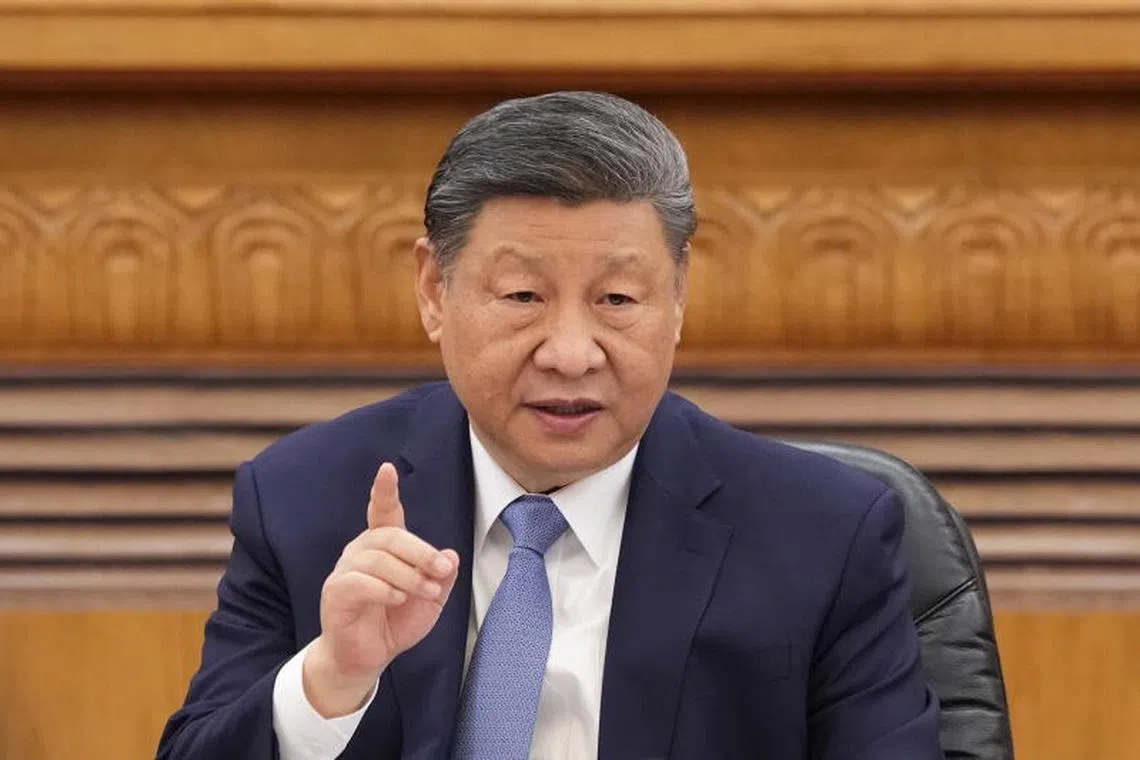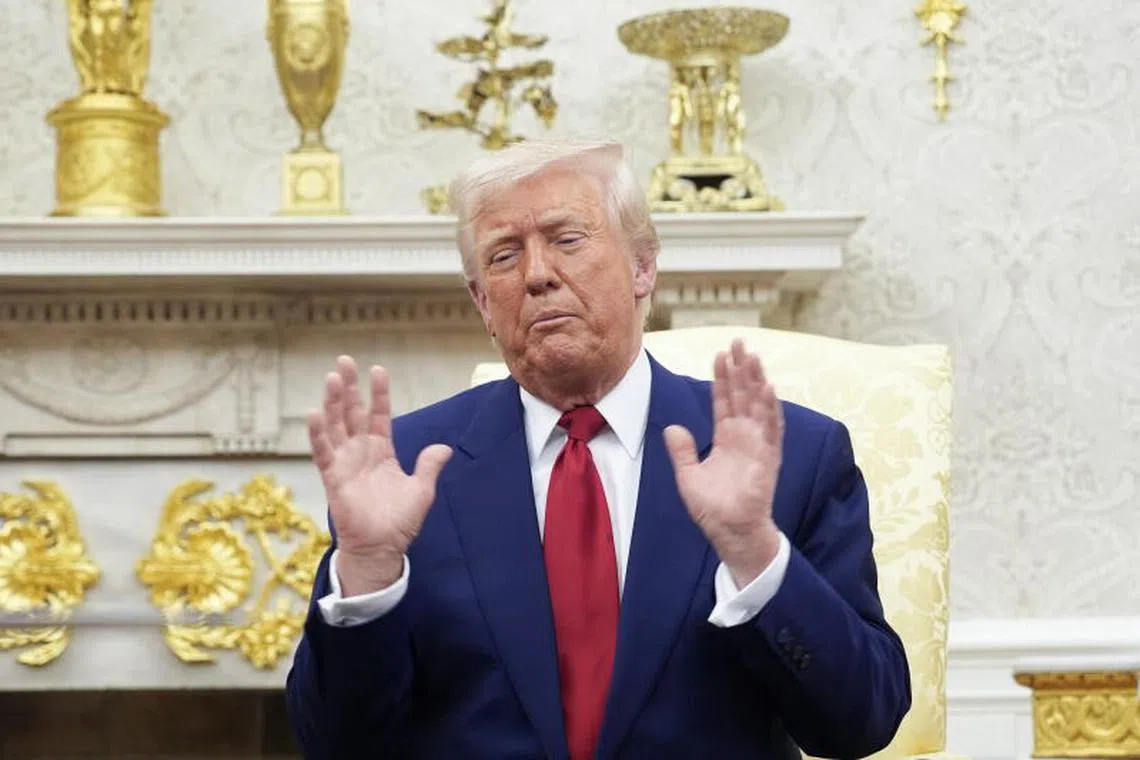China’s Xi switches to fight mode as Trump trade deal looks unlikely
Sign up now: Get ST's newsletters delivered to your inbox

China's President Xi Jinping speaks during a meeting with global business leaders at the Great Hall of the People, in Beijing.
PHOTO: EPA-EFE
Follow topic:
BEIJING - Chinese President Xi Jinping’s decision to quickly retaliate against US President Donald Trump’s sweeping tariffs sent the world a clear message: If the US wants a trade war, China is ready to fight.
After weeks of responding with only targeted measures and calling for dialogue, China signalled a tougher approach on April 4 by answering Mr Trump’s “reciprocal” tariffs with blanket duties of its own and more export controls.
The Communist Party’s official newspaper followed that up with an April 7 editorial declaring Beijing is no longer “clinging to illusions” of striking a deal, even as it leaves a door open to negotiations.
China’s defiant response has left investors bracing themselves for a prolonged and disruptive trade war.
Mr Trump deepened those worries on April 7, threatening an additional 50 per cent in tariffs
The 50 per cent charge would come on top of the 34 per cent duty the president imposed on all Chinese imports – set to begin on April 9 – as well as a 20 per cent levy that he put in place earlier tied to fentanyl trafficking, according to a White House official.
Mr Trump also warned in a social media post that the US would cut off all future meetings and negotiations with China if action was not taken in the coming days.
“We believe that before we can sit down to negotiate a deal we have to fight, because the other side wants to fight first,” Dr Wu Xinbo, director at Fudan University’s Centre for American Studies in Shanghai, said of China’s stance.
On the possibility of a Trump-Xi call, Dr Wu said: “You just slapped my face, and I’m not just going to call you and beg your pardon.”
As China confronts the reality that rising US levies – now at a rate Bloomberg Economics says will mostly wipe out bilateral trade – are unavoidable, top leaders are ramping up efforts to bolster the domestic economy.
Policymakers huddled in Beijing over the weekend to discuss plans to accelerate stimulus to boost consumption, Bloomberg News reported earlier, as Mr Xi leans on China’s vast consumer base to help absorb the country’s manufacturing output.
Mr Xi has called for strengthened efforts to “fully unleash” the country’s consumption potential to spur growth, China’s state-run broadcaster reported on April 7, without specifying when and where he made those comments.
Stocks tumbled on concerns over the trade war’s impact on global trade, as relations between the world’s largest economies spiral.
Asia capped the worst day since 2008. A gauge of Chinese shares listed in Hong Kong fell into a bear market, while the city’s benchmark Hang Seng Index plunged the most since 1997. Europe’s Stoxx 600 tumbled more than 6 per cent at one point.
Pressure and pride
An escalation of tensions may dim the prospect of a leadership call in the near future. Mr Trump has not spoken to Mr Xi since returning to the White House, the longest a US president has gone without talking to his Chinese counterpart post-inauguration in 20 years.
“Trump and Xi are locked in a paradox of pressure and pride,” said Mr Craig Singleton, a senior fellow at the non-partisan Foundation for Defence of Democracies. “But here’s the dilemma: If Xi refuses to engage, the pressure escalates; if he engages too soon, he risks looking weak.”
The Chinese leader is walking a tightrope. He needs to project strength at home, while supporting an economy grappling with deflation.
A major challenge is restoring consumer confidence, which has been deeply shaken by a years-long housing slump that wiped out a significant chunk of their wealth.
Several major global banks – including UBS Group, Goldman Sachs Group and Morgan Stanley – sounded the alarm over the weekend
They warned the levies could put more pressure on already modest 2025 growth forecasts for China, which are already as low as 4 per cent – below the official target of about 5 per cent.
Growing arsenal
While Mr Xi has ramped up China’s response, he still has not hit full retaliation: Beijing has several tools it could reach for if tensions with Washington worsen.
If past actions were any guide, it could let the yuan weaken to offset the impact of tariffs, tighten export controls on critical minerals or increase pressure on US companies operating in China.
China may also widen its diplomatic outreach by building stronger economic ties elsewhere.
In March, trade officials from China, Japan and South Korea jointly called for open and fair trade.
During a recent visit to Brussels, Chinese Vice-Finance Minister Liao Min expressed a willingness to work with the European Union to defend the multilateral trading system. The Chinese Embassy in Ottawa also made similar overtures about partnering with Canada.
Mr Xi’s expected visit to South-east Asia later this month takes on added importance. Beijing will likely be watching what countries like Cambodia, Malaysia and Vietnam might offer Washington in hopes of tariff relief, and whether those moves could undercut Chinese interests.
“What may be tougher for China to manage would be the knock-on protectionist measures other economies will take to shield their industries from an expected flood of cheaper Chinese goods as demand in the US and other key markets tighten,” said Ms Lee Sue-Ann, senior fellow at the ISEAS – Yusof Ishak Institute.
Despite the increased pressure, there is no clear sign that China is looking to fully decouple from the US. Instead, it seems to be asserting its position and bracing itself for a prolonged standoff, while keeping future options open.
“China wants to convey to the US that it is not intimidated and is willing to stand its ground,” said Dr Henry Gao, a law professor at Singapore Management University, who researches Chinese trade policies. “Rather than aiming to inflict significant damage, the goal seems to be to exert pressure and encourage dialogue.”

US President Donald Trump has not spoken to Mr Xi Jinping since returning to the White House.
PHOTO: EPA-EFE
Reduced reliance
China’s confidence this time around stems from the belief that it is better prepared than it was during Mr Trump’s first trade war, having learned from the past eight years. Beijing has broadened its network of trade partners, reducing its dependence on the US for both imports and exports.
The US took less than 15 per cent of Chinese exports last year, down from 19 per cent in 2017 before the trade war, although trade routed through third countries likely made up for some of the shortfall. Imports from the US – already relatively small – have become less critical for China.
Agricultural products are a prime example, with China seeking to reduce its reliance on US soybeans. American exporters – which once dominated the Chinese market – saw their share fall to just 20 per cent last year as China ramped up purchases from Brazil instead.
All this may buy China more time until the two sides agree to meet at the negotiation table.
China expects Mr Trump’s efforts will run out of momentum soon, according to Dr Wang Yiwei, professor of international relations at Renmin University.
“Soldiers would be most willing to fight when the first battle drum sounds, but that begins to fade by the second round,” he told Bloomberg, citing an old Chinese saying. BLOOMBERG

